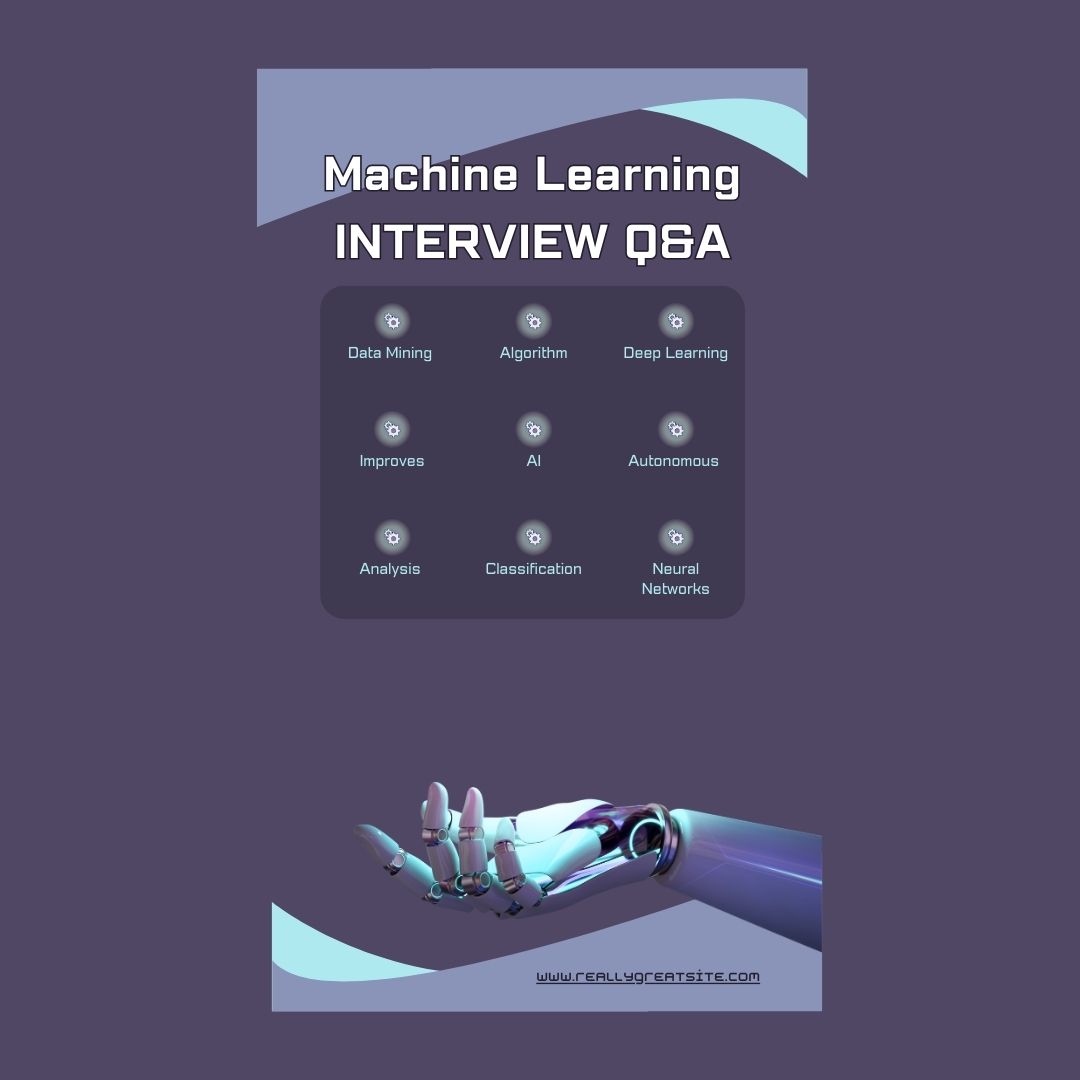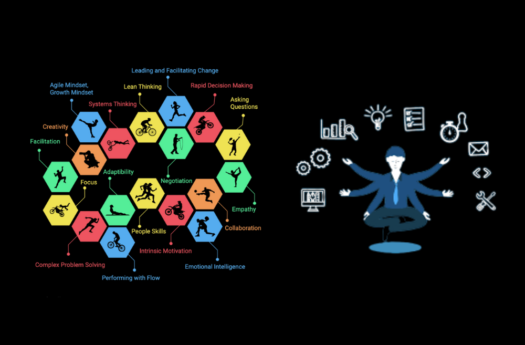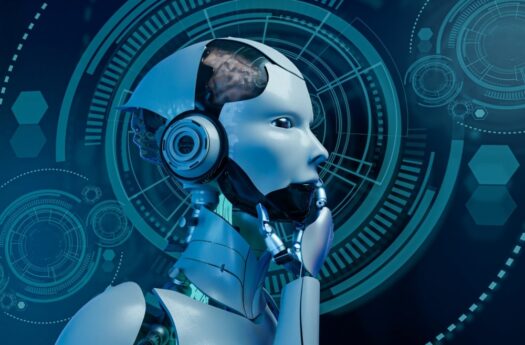
100 Machine Learning Interview Questions and Answers for Beginners 2024
Table of Contents
Toggle1. What is Machine Learning?
Answer: Machine learning is a subset of artificial intelligence that enables systems to learn from data, identify patterns, and make decisions with minimal human intervention.
2. What is the difference between supervised and unsupervised learning?
Answer: In supervised learning, the model is trained on labeled data, where the correct output is provided. In unsupervised learning, the model is trained on unlabeled data and must find patterns and relationships on its own.
3. What is overfitting and underfitting in machine learning?
Answer: Overfitting occurs when a model learns the training data too well, capturing noise rather than the underlying distribution. Underfitting happens when a model is too simple to capture the underlying trends in the data.
4. Explain the bias-variance tradeoff.
Answer: The bias-variance tradeoff is the balance between a model’s ability to minimize bias (error due to overly simplistic assumptions) and variance (error due to too much complexity). Ideally, one aims to find a model that minimizes both.
5. What is cross-validation?
Answer: Cross-validation is a technique used to assess how the results of a statistical analysis will generalize to an independent dataset. It involves partitioning the dataset into complementary subsets, training the model on one subset and validating it on the other.
6. Describe the concept of feature engineering.
Answer: Feature engineering is the process of using domain knowledge to create new input features from existing ones, which can improve the performance of machine learning models.
7. What is a confusion matrix?
Answer: A confusion matrix is a table used to evaluate the performance of a classification model. It summarizes the correct and incorrect predictions, showing true positives, true negatives, false positives, and false negatives.
8. What are precision and recall?
Answer: Precision is the ratio of true positive predictions to the total predicted positives, while recall is the ratio of true positives to the total actual positives. They are used to evaluate the effectiveness of a classification model.
9. What is the ROC curve?
Answer: The ROC (Receiver Operating Characteristic) curve is a graphical representation of a classifier’s performance. It plots the true positive rate against the false positive rate at various threshold settings.
10. What is the purpose of regularization in machine learning?
Answer: Regularization techniques, such as L1 and L2 regularization, are used to prevent overfitting by adding a penalty for large coefficients in the model. This encourages simpler models that generalize better to unseen data.
11. Explain the difference between L1 and L2 regularization.
Answer: L1 regularization (Lasso) adds the absolute value of the coefficients as a penalty term to the loss function, promoting sparsity in the model. L2 regularization (Ridge) adds the square of the coefficients as a penalty, leading to smaller coefficients but not necessarily sparsity.
12. What is gradient descent?
Answer: Gradient descent is an optimization algorithm used to minimize the loss function of a model. It iteratively adjusts the model’s parameters in the direction of the negative gradient of the loss function.
13. What is a neural network?
Answer: A neural network is a computational model inspired by the human brain, consisting of interconnected nodes (neurons) organized in layers. Neural networks can learn complex patterns and are used in various applications, including image and speech recognition.
14. What is the difference between a perceptron and a multi-layer neural network?
Answer: A perceptron is a simple model consisting of a single layer of output nodes, making it suitable for linearly separable problems. A multi-layer neural network contains one or more hidden layers, allowing it to learn complex, non-linear relationships.
15. What are activation functions? Name a few.
Answer: Activation functions introduce non-linearity into the neural network, enabling it to learn complex patterns. Common activation functions include the sigmoid, ReLU (Rectified Linear Unit), and softmax functions.
16. What is overfitting and how can it be prevented?
Answer: Overfitting occurs when a model learns the training data too well, capturing noise rather than the underlying distribution. It can be prevented using techniques such as cross-validation, regularization, early stopping, and pruning.
17. What is reinforcement learning?
Answer: Reinforcement learning is a type of machine learning where an agent learns to make decisions by taking actions in an environment to maximize cumulative reward. It involves exploring the environment and exploiting known information.
18. What is deep learning?
Answer: Deep learning is a subset of machine learning that uses neural networks with many layers (deep architectures) to model complex patterns in large datasets. It is particularly effective in tasks such as image and speech recognition.
19. Explain the difference between batch and online learning.
Answer: Batch learning involves training a model on the entire dataset at once, while online learning updates the model incrementally as new data arrives. Online learning is useful for scenarios where data is continuously generated.
20. What is natural language processing (NLP)?
Answer: Natural Language Processing (NLP) is a field of artificial intelligence that focuses on the interaction between computers and humans through natural language. It involves tasks such as language translation, sentiment analysis, and text generation.
21. What is the purpose of feature scaling?
Answer: Feature scaling is used to normalize the range of independent variables in the data, which can improve the performance of algorithms sensitive to the scale of the input data, such as gradient descent and k-means clustering.
22. Describe the k-nearest neighbors (k-NN) algorithm.
Answer: The k-nearest neighbors algorithm is a non-parametric classification method that classifies a data point based on the majority class among its k closest neighbors in the feature space.
23. What is principal component analysis (PCA)?
Answer: Principal component analysis (PCA) is a dimensionality reduction technique that transforms data into a new coordinate system, where the greatest variance is captured by the first coordinates (principal components).
24. Explain the concept of clustering.
Answer: Clustering is an unsupervised learning technique used to group similar data points together based on certain features. Common clustering algorithms include k-means, hierarchical clustering, and DBSCAN.
25. What is the difference between classification and regression?
Answer: Classification involves predicting categorical labels (e.g., spam or not spam), while regression involves predicting continuous values (e.g., housing prices).
26. What is a support vector machine (SVM)?
Answer: A support vector machine is a supervised learning algorithm that can classify data by finding the hyperplane that maximizes the margin between different classes.
27. Explain what a decision tree is.
Answer: A decision tree is a flowchart-like structure used for classification and regression tasks, where internal nodes represent tests on features, branches represent outcomes, and leaf nodes represent class labels or regression values.
28. What is ensemble learning?
Answer: Ensemble learning is a technique that combines multiple models to improve overall performance. Common ensemble methods include bagging, boosting, and stacking.
29. What is the purpose of the learning rate in gradient descent?
Answer: The learning rate determines the size of the steps taken during optimization. A small learning rate may slow down convergence, while a large learning rate can lead to overshooting the minimum.
30. Describe what cross-entropy loss is.
Answer: Cross-entropy loss is a loss function used in classification tasks to measure the difference between the true distribution of labels and the predicted probabilities. It is commonly used in logistic regression and neural networks.
31. What is transfer learning?
Answer: Transfer learning is a technique where a model trained on one task is reused or fine-tuned for a different but related task, leveraging the knowledge gained from the initial training.
32. Explain the difference between bagging and boosting.
Answer: Bagging (Bootstrap Aggregating) combines the predictions of multiple models trained independently on different subsets of the data to reduce variance. Boosting sequentially trains models, where each model tries to correct the errors of the previous one, thereby reducing bias.
33. What are outliers, and how can they affect a model?
Answer: Outliers are data points that differ significantly from other observations. They can skew results, lead to poor model performance, and affect metrics such as mean and variance.
34. Describe the steps in the data preprocessing pipeline.
Answer: The data preprocessing pipeline typically includes the following steps: data cleaning, data integration, data transformation (e.g., normalization, encoding), feature selection, and data splitting into training and test sets.
35. What is the curse of dimensionality?
Answer: The curse of dimensionality refers to various phenomena that arise when analyzing and organizing data in high-dimensional spaces. As the number of dimensions increases, the amount of data needed to generalize effectively grows exponentially.
36. Explain the purpose of a validation set.
Answer: A validation set is a subset of the data used to tune model hyperparameters and evaluate model performance during training. It helps prevent overfitting by providing a check on the model’s ability to generalize to unseen data.
37. What is time series forecasting?
Answer: Time series forecasting involves predicting future values based on previously observed values. It is commonly used in fields like finance, economics, and weather forecasting.
38. What are the differences between LSTM and traditional RNNs?
Answer: Long Short-Term Memory (LSTM) networks are a type of recurrent neural network (RNN) designed to capture long-range dependencies in sequences. Unlike traditional RNNs, LSTMs have mechanisms to retain and forget information, reducing issues like vanishing gradients.
39. Describe the purpose of dropout in neural networks.
Answer: Dropout is a regularization technique that randomly sets a portion of neurons to zero during training to prevent overfitting. It forces the network to learn redundant representations and improves generalization.
40. What is a generative adversarial network (GAN)?
Answer: A generative adversarial network is a deep learning framework consisting of two neural networks, a generator and a discriminator, that compete against each other to create realistic data. The generator creates data, while the discriminator evaluates its authenticity.
41. What is hyperparameter tuning?
Answer: Hyperparameter tuning involves adjusting the parameters that govern the training process of a machine learning model, such as learning rate, batch size, and number of hidden layers, to optimize performance.
42. What is a convolutional neural network (CNN)?
Answer: A convolutional neural network is a type of deep learning model primarily used for processing grid-like data, such as images. It uses convolutional layers to automatically learn spatial hierarchies of features.
43. What is feature selection?
Answer: Feature selection is the process of identifying and selecting a subset of relevant features from the original dataset, aiming to improve model performance, reduce overfitting, and decrease computational cost.
44. What are hyperplanes in SVM?
Answer: In support vector machines, hyperplanes are decision boundaries that separate different classes in the feature space. The optimal hyperplane maximizes the margin between classes, which is the distance between the hyperplane and the nearest data points of any class.
45. Explain the concept of model interpretability.
Answer: Model interpretability refers to the degree to which a human can understand the reasons behind a model’s predictions. It is important for building trust and accountability in machine learning applications, especially in sensitive areas like healthcare and finance.
46. What is the purpose of the Adam optimizer?
Answer: The Adam (Adaptive Moment Estimation) optimizer is an optimization algorithm that combines the advantages of two other extensions of stochastic gradient descent: AdaGrad and RMSProp. It adapts the learning rate for each parameter and helps in faster convergence.
47. What is the role of a loss function?
Answer: A loss function quantifies the difference between the predicted output and the actual output in a machine learning model. It guides the optimization process by providing feedback on how well the model is performing.
48. Describe the concept of explainable AI (XAI).
Answer: Explainable AI (XAI) refers to methods and techniques that make the output of machine learning models understandable to humans. It aims to provide insights into how models make decisions, enhancing transparency and trust.
49. What are recommendation systems?
Answer: Recommendation systems are algorithms used to suggest products, services, or content to users based on their preferences and behavior. They can be collaborative filtering, content-based, or hybrid approaches.
50. What is data augmentation?
Answer: Data augmentation is a technique used to increase the diversity of training data by applying various transformations, such as rotation, scaling, and flipping, to create modified versions of existing data points.
51. What is the difference between parametric and non-parametric models?
Answer: Parametric models assume a specific form for the underlying function and have a fixed number of parameters, while non-parametric models do not assume any specific form and can adapt their complexity based on the amount of data available.
52. What is feature extraction?
Answer: Feature extraction is the process of transforming raw data into a set of measurable properties (features) that can be used for analysis. It is often employed to reduce dimensionality while preserving relevant information.
53. What is a training set?
Answer: A training set is a subset of data used to train a machine learning model. The model learns patterns and relationships in the training set, which it later applies to make predictions on new, unseen data.
54. Explain the concept of ensemble methods.
Answer: Ensemble methods combine predictions from multiple models to improve overall performance. They leverage the strengths of different models to reduce variance (bagging), bias (boosting), or both (stacking).
55. What are the different types of machine learning algorithms?
Answer: The main types of machine learning algorithms include supervised learning (e.g., regression, classification), unsupervised learning (e.g., clustering, association), and reinforcement learning.
56. What is the importance of data cleaning?
Answer: Data cleaning is crucial for removing inaccuracies and inconsistencies in the dataset, which can lead to improved model performance. It helps ensure that the data used for training is reliable and representative.
57. What are the challenges of working with unstructured data?
Answer: Unstructured data, such as text, images, and videos, poses challenges like the need for advanced processing techniques, difficulty in extracting meaningful features, and higher computational requirements for analysis.
58. Describe what a random forest is.
Answer: A random forest is an ensemble learning method that constructs a multitude of decision trees during training and outputs the mode of their predictions (for classification) or mean prediction (for regression) to improve accuracy and control overfitting.
59. What is a model evaluation metric?
Answer: A model evaluation metric is a quantitative measure used to assess the performance of a machine learning model. Common metrics include accuracy, precision, recall, F1 score, and mean squared error, among others.
60. Explain the purpose of a test set.
Answer: A test set is a subset of data used to evaluate the final performance of a machine learning model after training and validation. It provides an unbiased assessment of how well the model generalizes to new, unseen data.
61. What is the role of a data scientist?
Answer: A data scientist is responsible for analyzing and interpreting complex data to help organizations make data-driven decisions. They use statistical methods, machine learning, and data visualization to extract insights from data.
62. What is a model’s training accuracy?
Answer: Training accuracy is the percentage of correctly predicted instances in the training dataset. It measures how well the model fits the training data but does not necessarily indicate its performance on unseen data.
63. Explain the concept of active learning.
Answer: Active learning is a machine learning approach where the model selects the most informative data points to learn from, allowing it to achieve better performance with fewer labeled examples.
64. What is the purpose of data normalization?
Answer: Data normalization is the process of scaling individual samples to have a mean of zero and a standard deviation of one. It helps improve the convergence speed of gradient descent and ensures that features contribute equally to the distance calculations.
65. Describe what k-means clustering is.
Answer: K-means clustering is a popular unsupervised learning algorithm that partitions data into k distinct clusters based on feature similarity. It iteratively assigns data points to the nearest cluster centroid and updates centroids until convergence.
66. What is the purpose of the softmax function?
Answer: The softmax function is used in multi-class classification problems to convert raw model outputs (logits) into probabilities that sum to one, enabling the selection of the most probable class.
67. What are autoencoders?
Answer: Autoencoders are neural networks used for unsupervised learning, designed to learn efficient representations of data by encoding the input into a lower-dimensional space and then decoding it back to reconstruct the original input.
68. What is an attention mechanism in neural networks?
Answer: An attention mechanism allows neural networks to focus on specific parts of the input data when making predictions, improving performance in tasks like machine translation and image captioning.
69. Explain the concept of adversarial training.
Answer: Adversarial training is a technique used to improve the robustness of machine learning models by training them on both original and adversarial examples—crafted inputs designed to fool the model.
70. What is a logistic regression model?
Answer: Logistic regression is a statistical model used for binary classification tasks. It estimates the probability of a binary outcome based on one or more predictor variables using the logistic function.
71. Describe the role of bias in machine learning models.
Answer: Bias in machine learning refers to the error introduced by approximating a real-world problem with a simplified model. High bias can lead to underfitting, while low bias with high variance may result in overfitting.
72. What is the purpose of a confusion matrix?
Answer: A confusion matrix provides a visual representation of a classification model’s performance by summarizing the number of correct and incorrect predictions across different classes.
73. Explain the difference between hard and soft classification.
Answer: Hard classification assigns a single label to each instance, while soft classification provides probabilities for each class, indicating the uncertainty of predictions.
74. What is an out-of-sample error?
Answer: Out-of-sample error refers to the error of a model when applied to new, unseen data. It is a key measure of a model’s generalization ability.
75. What are some common types of regression models?
Answer: Common types of regression models include linear regression, polynomial regression, logistic regression, ridge regression, and Lasso regression.
76. Describe the use of hyperparameter optimization techniques.
Answer: Hyperparameter optimization techniques, such as grid search, random search, and Bayesian optimization, are used to systematically explore different hyperparameter configurations to find the optimal settings for model performance.
77. What is a naive Bayes classifier?
Answer: A naive Bayes classifier is a probabilistic classification model based on Bayes’ theorem, assuming independence between features. It is commonly used for text classification tasks.
78. What are the limitations of traditional machine learning methods?
Answer: Traditional machine learning methods may struggle with high-dimensional data, complex patterns, and require extensive feature engineering. They also may not perform well on unstructured data compared to deep learning approaches.
79. What is the significance of the F1 score?
Answer: The F1 score is a measure of a model’s accuracy that considers both precision and recall, providing a single metric for performance, particularly useful in imbalanced classification problems.
80. Explain the term “data leakage.”
Answer: Data leakage occurs when information from the test set is used during training, leading to overly optimistic performance estimates. It compromises the model’s ability to generalize to new data.
81. What is reinforcement learning?
Answer: Reinforcement learning is a type of machine learning where an agent learns to make decisions by receiving rewards or penalties based on its actions within an environment, aiming to maximize cumulative reward.
82. What is a gradient boosting machine?
Answer: A gradient boosting machine is an ensemble learning method that builds models sequentially, where each new model is trained to correct the errors of the previous models. It is particularly effective for regression and classification tasks.
83. Describe what feature importance means.
Answer: Feature importance measures the contribution of each feature to the model’s predictions. It helps identify which features are most influential in making predictions and can guide feature selection.
84. What is a characteristic of a well-structured dataset?
Answer: A well-structured dataset is organized, consistent, and free from missing or erroneous values. It allows for straightforward analysis and improves the performance of machine learning models.
85. What is a multi-class classification problem?
Answer: A multi-class classification problem involves classifying instances into one of three or more classes, as opposed to binary classification, which only involves two classes.
86. What is the difference between a statistical model and a machine learning model?
Answer: Statistical models are based on established theoretical assumptions about the data, while machine learning models often rely on empirical methods to learn patterns without predefined assumptions.
87. What is the role of a data engineer?
Answer: A data engineer is responsible for designing, building, and maintaining the systems that store and process data, ensuring data is accessible and usable for analysis and modeling by data scientists and analysts.
88. What are some techniques for imbalanced dataset handling?
Answer: Techniques for handling imbalanced datasets include resampling methods (oversampling and undersampling), using different evaluation metrics (e.g., F1 score), and employing algorithms designed for imbalanced data.
89. What is the difference between deterministic and stochastic models?
Answer: Deterministic models produce the same output from a given initial condition, while stochastic models incorporate randomness and can produce different outputs from the same initial conditions due to inherent uncertainty.
90. What is the significance of the AUC-ROC curve?
Answer: The AUC-ROC (Area Under the Receiver Operating Characteristic curve) measures the model’s ability to distinguish between classes. A higher AUC indicates better model performance across different threshold values.
91. What are some common evaluation metrics for regression models?
Answer: Common evaluation metrics for regression models include mean absolute error (MAE), mean squared error (MSE), root mean squared error (RMSE), and R-squared.
92. What is an activation function?
Answer: An activation function is a mathematical function applied to a neural network’s output to introduce non-linearity, allowing the network to learn complex relationships. Common activation functions include ReLU, sigmoid, and tanh.
93. Explain what model bias is.
Answer: Model bias refers to the systematic error introduced by approximating a real-world problem with a simplified model. High bias can lead to underfitting, where the model fails to capture the underlying trends in the data.
94. What is the purpose of dimensionality reduction?
Answer: Dimensionality reduction aims to reduce the number of features in a dataset while retaining essential information. It helps improve model performance, reduce overfitting, and decrease computational complexity.
95. Describe the concept of clustering algorithms.
Answer: Clustering algorithms group data points based on their similarity or distance from one another. They are commonly used in unsupervised learning tasks to discover inherent structures within data.
96. What is a decision boundary?
Answer: A decision boundary is a surface in the feature space that separates different classes predicted by a classification model. It defines how the model categorizes input data based on its learned parameters.
97. What are some common techniques for feature extraction?
Answer: Common techniques for feature extraction include Principal Component Analysis (PCA), t-Distributed Stochastic Neighbor Embedding (t-SNE), and using domain-specific heuristics to derive features from raw data.
98. What is the importance of data visualization?
Answer: Data visualization is crucial for understanding data patterns, trends, and insights. It helps in communicating findings effectively, identifying anomalies, and guiding data-driven decision-making.
99. What is a hyperparameter?
Answer: A hyperparameter is a configuration setting used to control the training process of a machine learning model. Unlike model parameters, hyperparameters are set before training begins and influence model performance.
100. What is cross-validation, and why is it important?
Answer: Cross-validation is a technique used to evaluate a model’s performance by partitioning the data into subsets for training and validation. It helps ensure the model generalizes well to unseen data, reducing the risk of overfitting.











